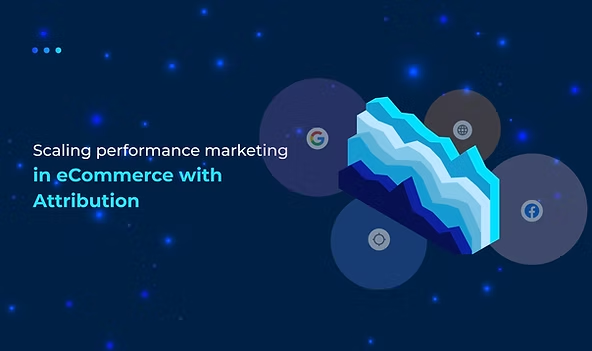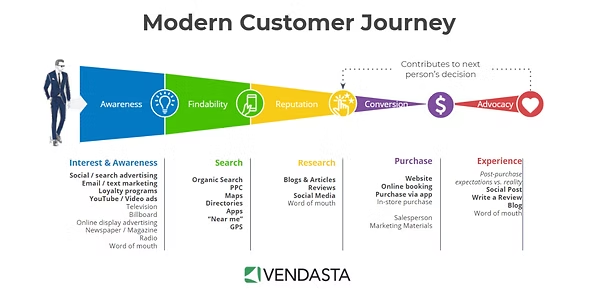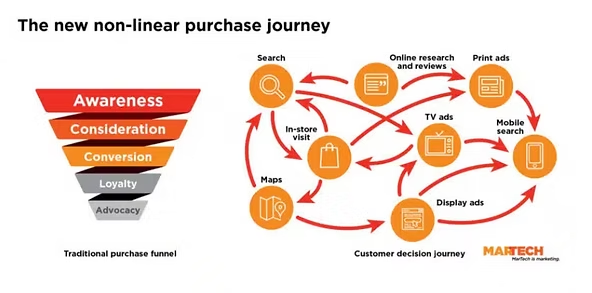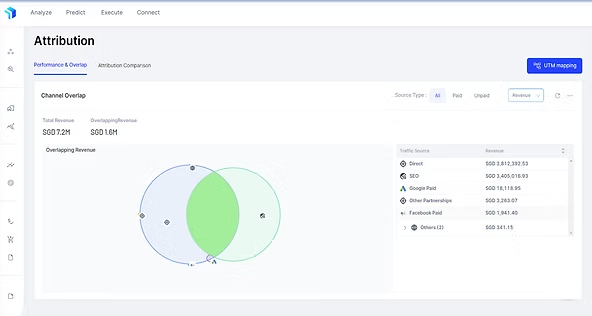
E-commerce performance marketing helps in building the first point of contact with consumers in most cases. However, as more businesses vie for customer attention, ad spends and customer acquisition costs continue to rise.
Today, customer purchase journeys have become non-linear in nature as buyers deal with brands through different touch points before they make the final decision.
This complex, multi-touch marketing demands a deeper understanding of campaign effectiveness. This is where attribution becomes crucial. By accurately tracking and analyzing the impact of each marketing touchpoint, businesses can optimize their strategies and maximize return on investment.
In this blog, we’ll discuss:
Let’s dive right in!
Attribution in eCommerce performance marketing is the process of identifying which marketing efforts lead to customer conversions.
It aids eCommerce merchants in knowing what particular channels and touchpoints result in sales to ensure a better allocation of resources and strategies.
Points to note about attribution in eCommerce:
Through efficient implementation of attribution models, eCommerce companies can obtain insights into their customers’ buying patterns.
Attribution plays a crucial role in eCommerce performance marketing. Here's why it's so important:
Attribution narrows down the common denominator to calculate Marketing Return on Investment (ROI). If you are able to determine who clicked which channel and what touch points before conversion, you would know the monetary cost of that marketing endeavor.
According to iProspect, “the typical outcome of implementing attribution is a 15-35% gain in media efficiency and corresponding increases in ROI”.
For example, let's say you spend $1,000 on a social media campaign and $1,500 on email marketing. Without proper attribution, you might see that email marketing directly led to 50 conversions while social media led to 30. However, with a multi-touch attribution model, you might discover that social media actually influenced 70% of email-driven conversions. This insight would dramatically change your understanding of each channel's ROI.
Attribution data allows you to further improve the performance of your marketing activities. You know what you wish to achieve - increasing the number of conversions in this case – and therefore you know how to change the messaging, the timing, and the channel selection accordingly.
For instance, your attribution model reports that customers with no less than three interactions on different brand channels before making a purchase tend to have a 50% increase in average order value. With this insight, you could plan to launch a campaign on multiple channels to create more interactions resulting in higher net value for the business.
Besides, depending on insights data, you can quite easily pinpoint underperforming channels or campaigns. For instance, if you discover that a specific ad set or email funnel does not convert well, you can drop it and cut costs to support other efficient means, efforts, and resources.
Attribution not only helps your marketing team but also helps in enhancing the customer's experience. Getting to know the different stages of the customer journey helps you offer more pertinent interactions at each stage when needed.

For instance, if your attribution model shows that customers often research products on mobile devices but prefer to make purchases on desktops, you can optimize your mobile site for product information and your desktop site for seamless checkout.
You can also leverage the attribution model to optimize the customer journey. If a customer already visited some touchpoints, you can show them some offers or informational content instead of introductory Top-Of-The-Funnel (TOFU) information.
Attribution makes it feasible for efficient allocation of the marketing budget depending on the various channels’ performance.
Let us assume that your attribution model shows that display ads, although most likely not the final click before the consumer makes a purchase, are helpful in the early stages of getting to know the brand and the purchasing funnel. Without this insight, you might underfund display advertising. With it, you can allocate budget more appropriately to support the customer journey.
98% of retail business owners consider attribution an essential component of their MarTech stack. It allows them to identify the channels driving the most sales.
However, eCommerce attribution is a complex process that comes with various challenges. Let’s look at these -
Today's shoppers interact with brands across numerous channels before buying.

The customer may, for example, see a social media advertisement, go to the website, get a retargeting advertisement via email, read product reviews, and inquire on price comparison sites before buying the product. Because of this complicated consumption process, it is hard to pinpoint the particular touchpoint’s value that an attributable marketing campaign exerted on the overall sales conversion.
Also, different customers may have different routes to purchase, increasing further attribution problems. Organizations must be able to follow and investigate these paths in order to find out what contact points are most effective and at which stage of the process.
Traditional models like last-click attribution often fail to capture the entire customer journey.
It will treat the last click as the most effective touchpoint while missing out on other important engagements that came before it.
For instance, a customer might learn about your offering from a blog posting, and interact on social media with your brand, however, the conversion is credited to a PPC ad mid-way through the funnel.
This oversimplification can result in improper utilization of campaign budgets as the focus is placed on middle and bottom funnel mechanisms at the expense of top-funnel efforts. More sophisticated multi-touch attribution models are needed, but these come with their own implementation challenges.
Information regarding the customer is usually found in different locations e.g. website stats, CRM, email marketing, social media, and others. Such diffusion results in an inability to have a comprehensive view of the customer along their journey.
Inconsistencies between platforms, data silos, and missing data further complicate accurate attribution analysis.
Some marketers worry that attribution models may misinterpret customer behavior due to in-market bias.
For instance, a customer already intending to buy might interact with multiple touchpoints, leading the model to overvalue those interactions.
This can result in a skewed understanding of which marketing efforts are truly driving conversions. While attribution models provide valuable data, it's crucial to interpret results critically and consider other factors influencing purchase decisions.
Combining attribution data with other marketing metrics and customer insights can help provide a more balanced view.
For a more comprehensive look at these challenges, check out our detailed guide on challenges in eCommerce attribution.
eCommerce attribution is as challenging as it can get. There’s no such thing as 100% attribution in eCommerce, but by following some best practices, we can get as close to the source as possible.
To increase accuracy in attribution, enhance all data captured within the entire customer life cycle. This includes things like marketing channels, your eCommerce website, CRM systems, and tools for tracking online behavior.
This data integration enables addressing attribution issues since the entire customer journey can be visualized.
For example, a customer might:
Without fully integrating data, you may lose track of the first social media advertisement that created awareness. This would result in a lack of reliable attribution and sub-optimal marketing.
By using integrated data, you can assess and evaluate the contribution of each interaction stage to the conversion.
Selecting the appropriate attribution model is crucial for accurate performance measurement. Different models assign conversion credit in various ways:
Each model has pros and cons. For example, last-click is simple but ignores earlier influences, while data-driven models are powerful but require substantial-high-quality data.
Choose a model that aligns with your business goals, industry, and customer journey complexity. Regularly review and refine your chosen model as customer behavior and marketing channels evolve.
Data integration from multiple sources is labor-intensive and there is also a greater scope for making errors in it. Most companies lack the capacity to connect this data in a unified manner due to the complexity of data offered by different platforms.
For example, the structure of Facebook and Google AdWords data is not the same as eCommerce data structure, as well as, the ways of verifying the metrics may differ from one channel to the other.
These challenges can be addressed by an end-to-end eCommerce analytics platform such Graas:

Thus using this type of platform gives the opportunity to:
There’s no one-size-fits-all approach to attributing sales, but getting the basics right is crucial for improving your attribution results.
To ensure accurate attribution, the data you use must be clean and unified from all your sales and marketing channels. And Graas does all this for you with its AI-based attribution models.
And that’s not all. Graas also provides insights and recommendations to ensure that underperforming channels are either discontinued or optimized to produce better results.